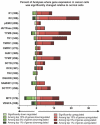Targeting Nucleotide Biosynthesis: A Strategy for Improving the Oncolytic Potential of DNA Viruses
- PMID: 29018771
- PMCID: PMC5622948
- DOI: 10.3389/fonc.2017.00229
Targeting Nucleotide Biosynthesis: A Strategy for Improving the Oncolytic Potential of DNA Viruses
Abstract
The rapid growth of tumors depends upon elevated levels of dNTPs, and while dNTP concentrations are tightly regulated in normal cells, this control is often lost in transformed cells. This feature of cancer cells has been used to advantage to develop oncolytic DNA viruses. DNA viruses employ many different mechanisms to increase dNTP levels in infected cells, because the low concentration of dNTPs found in non-cycling cells can inhibit virus replication. By disrupting the virus-encoded gene(s) that normally promote dNTP biosynthesis, one can assemble oncolytic versions of these agents that replicate selectively in cancer cells. This review covers the pathways involved in dNTP production, how they are dysregulated in cancer cells, and the various approaches that have been used to exploit this biology to improve the tumor specificity of oncolytic viruses. In particular, we compare and contrast the ways that the different types of oncolytic virus candidates can directly modulate these processes. We limit our review to the large DNA viruses that naturally encode homologs of the cellular enzymes that catalyze dNTP biogenesis. Lastly, we consider how this knowledge might guide future development of oncolytic viruses.
Keywords: adenovirus; cancer; herpes simplex virus-1; nucleotide metabolism; oncolytic virus; ribonucleotide reductase; thymidine kinase; vaccinia virus.
Figures


Similar articles
-
The Enhanced Tumor Specificity of TG6002, an Armed Oncolytic Vaccinia Virus Deleted in Two Genes Involved in Nucleotide Metabolism.Mol Ther Oncolytics. 2019 Mar 27;14:1-14. doi: 10.1016/j.omto.2019.03.005. eCollection 2019 Sep 27. Mol Ther Oncolytics. 2019. PMID: 31011628 Free PMC article.
-
Oncolytic virus therapy in Japan: progress in clinical trials and future perspectives.Jpn J Clin Oncol. 2019 Mar 1;49(3):201-209. doi: 10.1093/jjco/hyy170. Jpn J Clin Oncol. 2019. PMID: 30462296 Review.
-
Dual Ligand Insertion in gB and gD of Oncolytic Herpes Simplex Viruses for Retargeting to a Producer Vero Cell Line and to Cancer Cells.J Virol. 2018 Feb 26;92(6):e02122-17. doi: 10.1128/JVI.02122-17. Print 2018 Mar 15. J Virol. 2018. PMID: 29263257 Free PMC article.
-
Engineering and Characterization of Oncolytic Vaccinia Virus Expressing Truncated Herpes Simplex Virus Thymidine Kinase.Cancers (Basel). 2020 Jan 17;12(1):228. doi: 10.3390/cancers12010228. Cancers (Basel). 2020. PMID: 31963415 Free PMC article.
-
Oncolytic virus therapy for prostate cancer.Int J Urol. 2010 Jan;17(1):20-30. doi: 10.1111/j.1442-2042.2009.02383.x. Epub 2009 Oct 13. Int J Urol. 2010. PMID: 19832925 Review.
Cited by
-
Combinatorial Loss of the Enzymatic Activities of Viral Uracil-DNA Glycosylase and Viral dUTPase Impairs Murine Gammaherpesvirus Pathogenesis and Leads to Increased Recombination-Based Deletion in the Viral Genome.mBio. 2018 Oct 30;9(5):e01831-18. doi: 10.1128/mBio.01831-18. mBio. 2018. PMID: 30377280 Free PMC article.
-
Vaccinia-based vaccines to biothreat and emerging viruses.Biotechnol Genet Eng Rev. 2018 Apr;34(1):107-121. doi: 10.1080/02648725.2018.1471643. Epub 2018 May 21. Biotechnol Genet Eng Rev. 2018. PMID: 29779454 Free PMC article. Review.
-
Chemo-enzymatic synthesis of the exocyclic olefin isomer of thymidine monophosphate.Bioorg Med Chem. 2018 May 15;26(9):2365-2371. doi: 10.1016/j.bmc.2018.03.032. Epub 2018 Mar 22. Bioorg Med Chem. 2018. PMID: 29606487 Free PMC article.
-
Oncolytic vaccinia virus immunotherapy antagonizes image-guided radiotherapy in mouse mammary tumor models.PLoS One. 2024 Mar 18;19(3):e0298437. doi: 10.1371/journal.pone.0298437. eCollection 2024. PLoS One. 2024. PMID: 38498459 Free PMC article.
-
Unveiling the Connection: Viral Infections and Genes in dNTP Metabolism.Viruses. 2024 Sep 3;16(9):1412. doi: 10.3390/v16091412. Viruses. 2024. PMID: 39339888 Free PMC article. Review.
References
Publication types
LinkOut - more resources
Full Text Sources
Other Literature Sources

